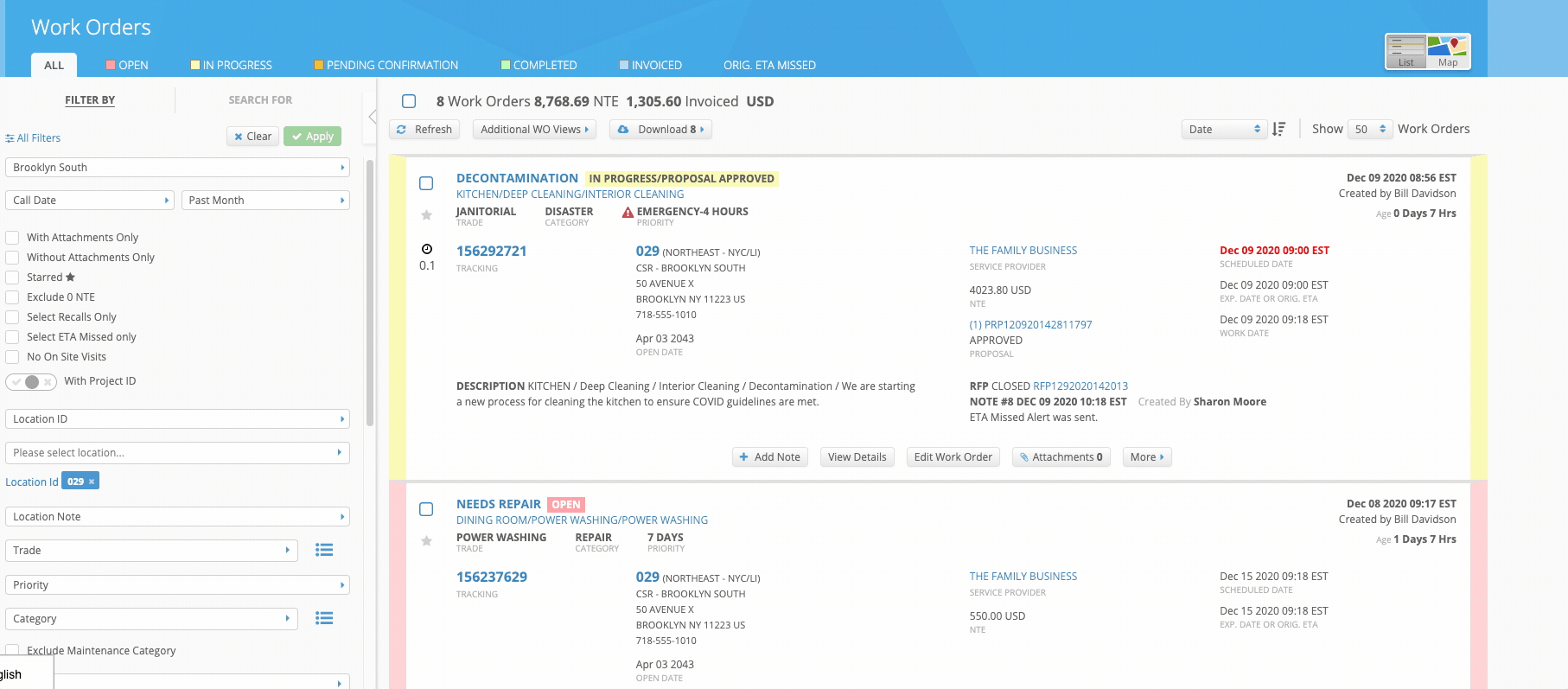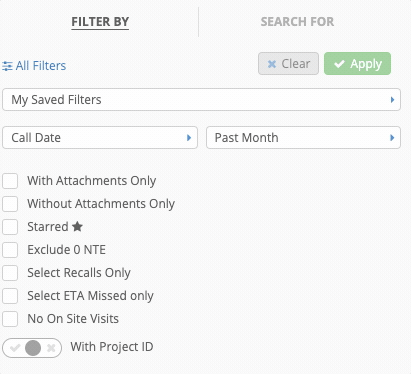Filtering Work Orders and Saving Filters
Filters help you find work orders you need to view or take action on. The following options to filter work orders are available:
- Filter By tab located on the left panel of the Work Orders List
- All Filters popup appears when you click the All Filters link
Most of the filters are available in both options, but the All Filters popup has a few additional filters.
You can also save selected filters for later use, select a default filter, as well as clear all filters to show all work orders.
Filter Criteria
You can filter work orders by date, amount, location, trade, category, provider, and other criteria.
Filters available both on the Filter By tab and in the All Filters popup:
- My Saved Filters. Select a saved filter to view matching work orders.
- Date. You may filter work orders by the following date types:
- Call date
- Scheduled date
- Completed date
- Invoice date
- Follow-up date
No Activity
For large businesses and/or corporations with work orders over 500,000 is reduced to 6 months and can use the No Activity on Work Orders under the Standard Dashboard in Analytics for details beyond 6 months for the No Activity filter.
There may be slight discrepancies in the results seen on the work order list view and the No Activity on Work Order Dashboard due to a few factors. For example, Analytics data refreshes hourly whereas the Work Order List View is real-time and Analytics also factors in some invoice updates.
- Range. Use this filter to find work orders for a specific time period. Note that you set the range for the selected Date. The available options are:
- Today
- Past month
- Past three months
- Past year
- Specific date range
Older than, which helps you locate work orders with the date older than the number of days defined in this filter.
The Older Than filter is available for Open and In Progress work orders only.
- With Attachments Only and Without Attachments Only. Select one of these checkboxes to get work orders with or without attachments.
- Starred. Locate work orders that you have marked with a star.
- Exclude 0 NTE. Exclude work orders with a zero NTE amount.
- Select Recalls Only Only view work orders recalls.
- Select ETA Missed Only Only view work orders with missed ETAs.
- No On Site Visits View work orders that did not have an on site visit.
- With Project ID View or exclude work orders that have a project ID.
- With Linked Orders View or exclude work orders that are linked.
- Location filters. Use this option to view work orders filtered by any of the following location detail:
Location ID
You can select multiple location IDs one by one from the dropdown OR paste a list of location IDs copied from an Excel sheet or any other document. Up to 600 IDs can be pasted. Ensure that each location ID in the copied list is placed on a separate line, as shown in the example below:
000
001
002
003
004- Location Name
- Address
- Region
- District
- City
- State/Province
Country
Store Open Date
For the Location ID, Region, District, State, and Country criteria, a dynamic drop-down list appears below where you can select the desired item or type in the name to narrow the search. For the Location Name, Address, and City criteria, type the information in the field below, and then press Enter.
You can filter your work orders by multiple location IDs, regions, districts, or states/provinces. When filtering by location name, address, city, country, or store open date, however, only one option can be specified.
- Location Note. You may filter work orders by those location note headers that are set up for your company in the Admin module. Select the desired location note, type in the required information in the text field below the Location Note dropdown, and press Enter.
- GL Code. Filter for work orders by GL Code. Entry must be an exact match of GL code name or value. You can enter multiple codes.
- Additional Approval Code. Filter for work orders by Additional Approval Codes. Entry must be an exact match of Additional Approval Code value. You can enter multiple codes.
- Trade. Use this dropdown to select trades one by one.
Alternatively, click the list icon to the right of the dropdown to view all trades in a popup. Select or deselect as many trades as required, and then click OK. The trades that you’ve selected appear below the Trade dropdown. - Priority. View work orders of the selected priority. Select all or desired priorities in the drop-down list by checking the boxes next to the priority names, and click Filter.
- Category. Use this dropdown to select categories one by one. Alternatively, click the list icon to the right of the dropdown to view all categories in a popup. Select or deselect as many categories as required, and then click OK. The categories that you’ve selected appear below the Category dropdown.
- Labels. Use this dropdown to select work orders with a specific Label applied, as done so when editing a work order.
- Weather Type. Use this dropdown to select work orders with a specific Weather Type applied, either through editing a work order or through the Dashboard.
Status. Apply this filter to view work orders in multiple statuses. When you need to get work orders only in one particular status, click the required tab at the top of the Work Orders List. See About Work Order Life Cycle and Statuses for more information.
The status tabs at the top of the Work Orders List — All, Open, In Progress, Completed, Invoiced — display work orders in the corresponding status. The All tab displays work orders in all statuses. However, to view work orders in multiple statuses at a time, for example, both in the Open and In Progress statuses, use the Status filter.
- Extended Statuses. Use this filter to view work orders in one or multiple extended statuses at a time. Open the drop-down list, select the required extended statuses, and click Filter. The page refreshes, and the selected extended statuses appear under the Extended Statuses dropdown.
- Exclude Invoiced Calls. Use this filter to hide work orders that have been invoiced.
- Select Verbal Approvals Only. List work orders where the Verbal approval box is checked in the Edit Work Order modal, indicating changes to the NTE amount were approved verbally and marked accordingly on the work order.
Exclude Internal Providers and Exclude External Providers. Hides work order assigned to internal or external providers, respectively.
To view work orders assigned to both internal and external service providers, clear both checkboxes.
- Provider. View work orders assigned to specific service providers. To select a provider, click the Provider dropdown, and select the desired provider name. Repeat to add more providers.
- Caller. Filter work orders by name of a specific caller, i.e., a name that you or someone from your company entered when creating a work order.
- Created By. Filter work orders by account used to create those work orders. Note that when multiple users create work orders using the same account — for example, a single account for a location with multiple users — all those work orders appear on the list.
- Problem Description. Filter work orders by problem description. Type in the desired keywords, and press Enter.
- Has Badge. Locate work orders with already assigned technicians — when a tech is assigned to a work order, their badge appears among work order attachments.
- Only Show Providers with Technicians. Find work orders allocated to service providers that have technicians.
Additional filters are available only in the All Filters popup:
- Select Recalls Only. List work orders created when the same problem re-occurs within 30 days after the original work order was completed.
- Select ETA Missed Only. Filter work orders where service providers missed the estimated time of arrival.
- No On Site Visits. List Open and In Progress work orders that have no check-in entries made by technicians via either the Interactive Voice Response (IVR) system or the ServiceChannel Provider mobile app.
- Show Void. Show voided work orders on the Void tab which appears on the top of the Work Orders List among other status tabs.
- Assignee. Use this dropdown to view work orders that have a particular assignee or no assignee at all. Available options are:
- No Assignee
- Has Assignee
- Assigned to Me
- The name of a particular user
- Asset Type. Find work orders with a specific asset type.
The most common reason filtering comes up empty is because the criteria have been entered too specifically. Should initial filtering come up empty, perform a broader search, and narrow it from there.
Filtering Work Orders Using the Filter By Tab
The Filter By tab is located on the panel to the left of the Work Orders List. This panel is expanded by default, but you can collapse it to view work orders better. Click the left arrow icon to collapse the panel, and click the arrow icon again to return to the expanded view.
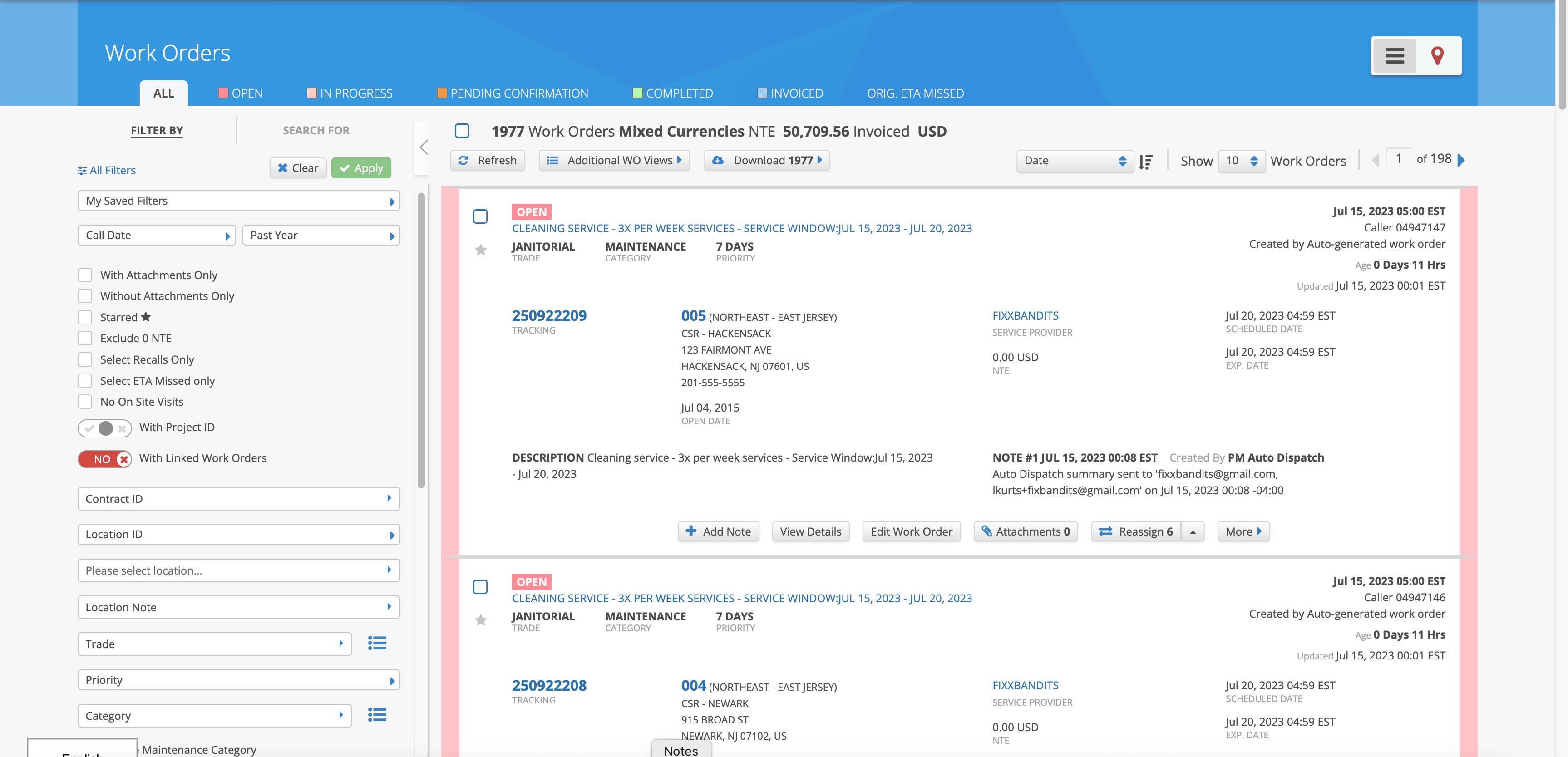
When on the Filter By tab, you can apply filters one by one — every time you select a filter, the Work Orders List refreshes and gives you results on the fly. Use this option when the number of work orders to filter is not large, and the number of filters to apply is small.
Filtering Work Orders Using the All Filters Popup
The All Filters includes all the filters that are available on the Filter By tab but also has extra filtering options. Use this popup when you want to select multiple filters and apply them all at once. In that case, the Work Orders List refreshes to display results matching all selected criteria.

Saving Filters and Managing Saved Filters
In your everyday work, you may need to apply the same set of filters over and over again.
For this purpose, once you select the filters you need, you may save them as a set and use this set later on. Also, you can select which of your saved filter sets should appear on QuickView. You can edit or even delete saved filters when you don’t need them anymore.
Your saved filters are only available to you. Saved filters cannot be shared with others.
You can create and manage saved filters on both the Filter By tab and in the All Filters popup.
- Select the desired filtering criteria.
- At the bottom of the filters list, click Save Current Filter. A text field appears.
- Enter the filter set name, and click Save Filter.
The filter is saved, and its name is displayed in the My Saved Filters drop-down list.
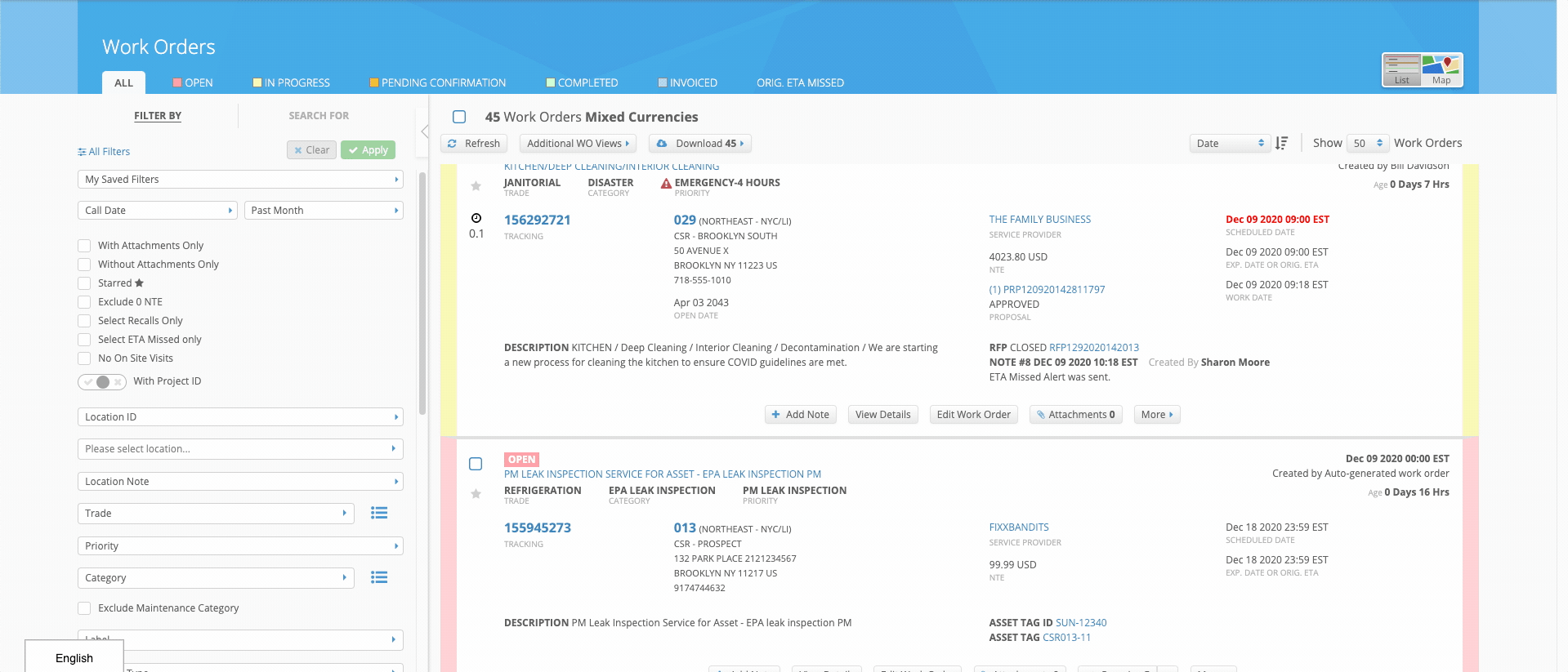
After you save a filter set, you may need to edit some of its options.
- In the My Saved Filters drop-down list, select the filter set you want to edit. The Work Orders List refreshes applying the selected filter set.
- Add or remove any filtering criteria as needed.
- At the bottom of the filters list, click Save Current Filter. The name of your selected filter appears in the text field.
- Click Update Existing Filter.
The filter set is updated.
When you don’t need a saved filter anymore, you can delete it.
- Click Edit Filters at the bottom of the left panel or the All Filters link. The popup with a list of saved filters appears.
- Click the trash icon next to the desired filter, and click Save.
The filter is deleted.
Creating a Default Filter
Once a created filter is saved, it can be used as a Default Filter. This gives you the opportunity to create a filter that is preferable to your needs and/or viewed on a consistent basis. For instance, you create a filter and select it as the default filter. You decide to leave the work order list page and return, the selected default filter will display with the necessary work orders associated within that filter. Perhaps, you logout of service automation and return the next day, the work order list page will display the selected default filter. You still can select another saved filter to view work orders without changing the default filter selection. The default filter will remain the filter of choice until you decide to change or remove the filter.
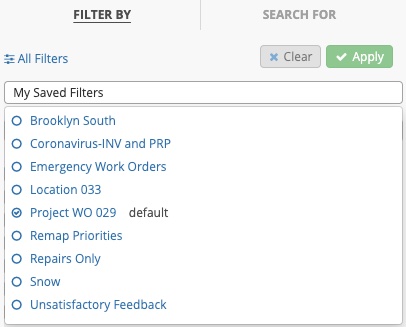
- From the My Saved Filters drop-down list, click the arrow to expand the list.
- Select a saved filter by clicking the Radio button to the left of the filter name and the page will load with work orders associated with the selected filter. The radio button has a Checkmark inside and the word Default is to the right of the chosen filter.
Changing the Default Filter
A default filter can be changed at any time. You can change the filter to one that has been created in the past or create a new filter and choose it as the default filter.
- From the My Saved Filters drop-down list, click the arrow to expand the list.
- Select a different saved filter by clicking the Radio button to the left of the filter name and the page will load with work orders associated with the selected filter. The radio button has a Checkmark and the word Default is to the right of the chosen filter.
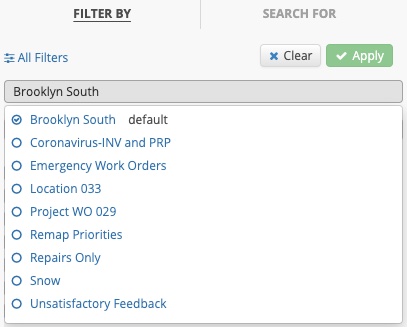
Removing the Default Filter
You can remove the selected default filter at any time. This will create a generic view when a saved filter is not selected as a default filter.
- From the My Saved Filters drop-down list, click the arrow to expand the list.
- Click the Radio button to remove the Checkmark and the page will load with a generic list view. You will no longer see a selected saved filter as the default filter.
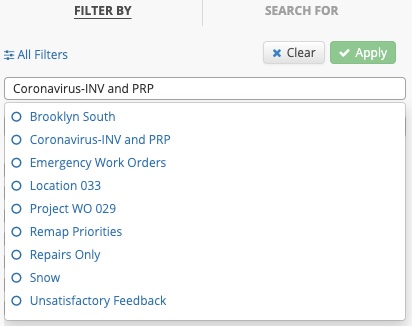
Clearing Filters
Once you are done with filtering work orders, you may deselect all applied filters by clicking Clear All Filters at the bottom of the Filter By tab, or All Filters popup. When you need to clear a specific filter, deselect the filter checkbox, or click X next to the filter.
